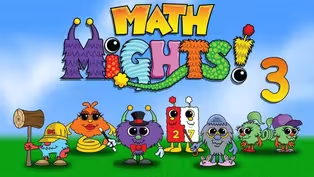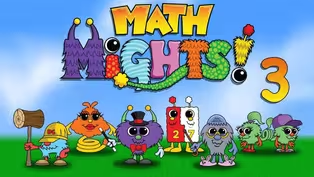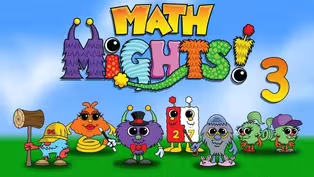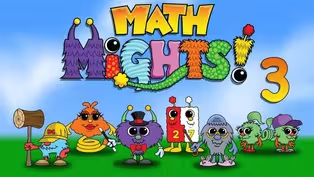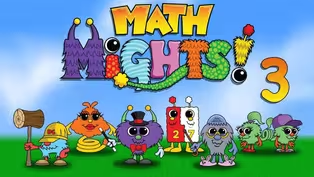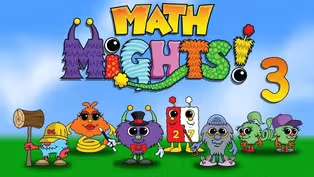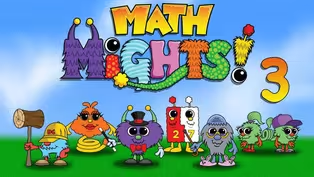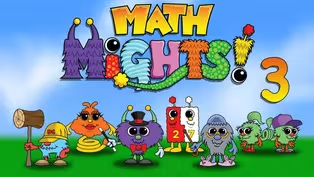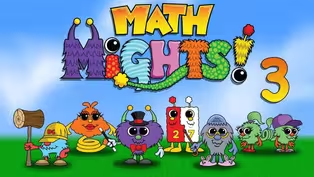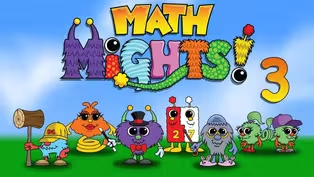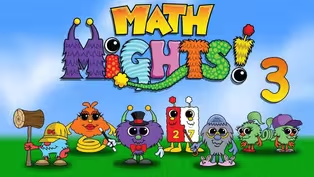Math Mights
Representing Division Part 1
Season 3 Episode 304 | 15m 59sVideo has Closed Captions
Join Ms. Askew and Professor Barble to see if you can match visual models to word problems
Join Ms. Askew and Professor Barble to see if you can match visual models to word problems. Next we are going to represent division with base ten blocks!
Problems playing video? | Closed Captioning Feedback
Problems playing video? | Closed Captioning Feedback
Math Mights is a local public television program presented by Detroit PBS
Math Mights
Representing Division Part 1
Season 3 Episode 304 | 15m 59sVideo has Closed Captions
Join Ms. Askew and Professor Barble to see if you can match visual models to word problems. Next we are going to represent division with base ten blocks!
Problems playing video? | Closed Captioning Feedback
How to Watch Math Mights
Math Mights is available to stream on pbs.org and the free PBS App, available on iPhone, Apple TV, Android TV, Android smartphones, Amazon Fire TV, Amazon Fire Tablet, Roku, Samsung Smart TV, and Vizio.
Providing Support for PBS.org
Learn Moreabout PBS online sponsorshipMore from This Collection
Video has Closed Captions
Join Ms. Askew for a tricky multi-step word problem with Professor Barble! (15m 59s)
Build Fraction from Unit Fractions
Video has Closed Captions
Join Ms. Askew for another multi-step word problem with Professor Barble! (15m 59s)
Video has Closed Captions
Join Ms. Askew for a division word problem with her friend Professor Barble. (15m 59s)
Video has Closed Captions
Join Ms. Askew for a division word problem with her friend Professor Barble. (16m)
Video has Closed Captions
Join Ms. Askew and Professor Barble to do a visual model with a word problem. (15m 59s)
Dividing with even larger numbers
Video has Closed Captions
Join Ms. Askew and Professor Barble to do a visual model with multiplication. (15m 59s)
Dividing with Larger Quotients
Video has Closed Captions
Join Ms. Askew and Professor Barble to see if you can match visual models to word problems (15m 59s)
Video has Closed Captions
Learn about multiplying one-digit whole numbers by multiples of 10. (15m 59s)
Video has Closed Captions
Learn about multiplying numbers larger than 20. (16m)
Video has Closed Captions
Join Mrs. Askew for a Number Talk with 2 Math Might Friends! (16m)
Multiply Teen Numbers with Larger Groups
Video has Closed Captions
Join Mrs. Askew for a Number talk with 2 Math Might Friends! (15m 59s)
Relating Multiplication and Division
Video has Closed Captions
Join Ms. Askew for a subtraction number talk with Springling! (16m)
Providing Support for PBS.org
Learn Moreabout PBS online sponsorship(cheerful music) - [Children] Math Mights!
- Welcome, third grade Math Might friends.
I'm so happy that you joined us today.
My name is Ms. Askew, and I can't wait to have fun learning about math.
But first, let's check out our plan for today.
First, we're gonna do a word problem with our friend Professor Barble.
After that, we're going to make sense of division representations.
Let's warm up our brains as Professor Barble helps us conquer word problems with visual models.
Now, you might be asking yourself, "What is a visual model?"
Well, a visual model is sometimes known as a model drawing, unit bar, tape diagram, or bar model.
A visual model is a reading comprehension strategy for word problems.
Drawing a visual model helps to visualize the strategies and understand what the word problem is asking.
I think we're gonna call on our friend, Professor Barble, to help us today.
(upbeat music) Professor Barble is a Math Might friend who lives in Mathville.
He likes to go on hikes searching for story problems to solve.
He likes to rush in and solve the problem right away, but he's learning that you have to go slow in order to go fast when solving story problems by using a step-by-step process that helps you think through what the problem is asking you.
When Professor Barble solves those story problems, he puts on his thinking cap so that it can help him create a visual model to solve the problem.
Can you guess what Professor Barble's story problem was today?
Take a look.
I wonder why Professor Barble drew that visual model that way.
Let's take a look and see what Ceena thinks.
Ceena thinks we need to multiply to find out how many candies there are in all.
Wait a minute, Ceena, you're trying to find the answer to the problem.
We don't wanna do that yet.
That's step six.
What we wanna do first is think about what the problem is asking us.
Let's see what Arti thinks.
Arti came up with this story problem to match Professor Barble's visual model.
There were five bags of candy with six pieces of candy in each bag.
How many pieces of candy in all?
Let's act it out on the whiteboard and see if Arti's story problem matches Professor Barble's visual model.
There are five bags of candy with six pieces of candy in each bag.
I can see that there are five bags and there are six pieces of candy in each bag.
We have a question mark at the end because the question is, how many pieces of candy in all?
That's what we're trying to find out.
Great job, Arti.
Your story problem does match Professor Barble's visual model.
Now let's go back and solve it.
We see that there are five bags and there are six pieces of candy in each bag.
Six plus six plus six plus six plus six.
Hmm, that sounds like repeated addition, and repeated addition is what?
Multiplication.
So let's go ahead and write that story problem on our whiteboard.
Five groups of six equals 30.
So to answer the question, there were 30 pieces of candy in all.
How does the visual model help you to understand what the story problem is asking?
Now, I know that story problems can be pretty overwhelming for third graders.
So a visual model is a great strategy to help you to see what the story of problem is asking you to do.
That way, you don't have to guess which operation to use.
Let's try another example.
Can you guess what Professor Barble's story problem was?
Arti came up with this story problem to match Professor Barble's visual model.
There are four cases of water with eight bottles of water in each.
How many water bottles are there in all?
I wonder which operation are we going to use?
Will we multiply, divide, add, or subtract?
We see that there are four cases with eight water bottles in each case.
We wanna figure out how many bottles there are in all.
So, if we take the four cases with eight water bottles in each, it looks like we're gonna multiply.
Four groups of eight equals 32.
So the answer to our question is, there are 32 water bottles in all.
Great job, Arti, solving that problem.
Now let's take a look at our I can statement for today.
I can make sense of representations of division.
Let's take a look at our first activity.
How could the blocks have been divided up to end up like this?
Looking at that activity, I see how the place value blocks ended up.
I wonder what the problem was to make us divide them that way way.
What do you think?
Ceena thinks the tens could have been divided into three groups, and then ones could have been divided into three groups until none were left.
Let's act that out on our whiteboard so that we can get a better understanding of what Ceena thinks.
Ceena says the tens could have been divided into three groups.
One, two, three.
And the ones could have been divided into three groups.
One, two, three.
I wonder what the division problem would be that matches this visual.
Hmm, we have 10, 20, 30, 31, 32, 33, 34, 35, 36, 37, 38, 39 total.
That would be our dividend, 39.
Those place value blocks were divided into three equal groups.
That would be the divisor.
How many were in each of those groups?
10, 11, 12, 13.
So 39 divided by three equals 13.
Wasn't it neat how we could use that visual aid to figure out what the problem was just by looking at the answer?
Let's try it the opposite way.
Let's try to use the base 10 blocks to divide 55 divided by five.
How would you divide them?
Let's act it out on the whiteboard.
We have the problem 55 divided by five.
Looking at our place value blocks, we see that we have a total of 55.
That's our dividend.
We wanna divide it equally into five groups.
So let's draw our five groups.
Now that we have our five groups, let's begin to divide our place value blocks.
10, 20, 30, 40, 50, 51 52, 53, 54, 55.
If we look at how many place value blocks are in each group, we see that there are 11.
So 55 divided by five equals 11.
Looking at our picture, I can clearly see how 55 divided by five equals 11.
Let's try to use the base 10 blocks to divide 65 divided by five.
I wonder if this problem is going to be just as easy as the last one.
Let's find out what Ceena and Arti thinks.
Arti wonders if we will be able to divide it equally.
Ceena wonders if we will have any left over.
We have 65 place value blocks, and that equals our total or our dividend.
We wanna divided into five equal groups.
That's our divisor.
So let's draw our five equal groups.
Let's begin to divide the place value blocks equally into those five groups.
10, 20, 30, 40, 50.
Wait a minute, I have a group of 10, but how can I put it in one of our groups equally?
We know that one ten is equal to 10 ones.
So we can take this 10 and break it apart into 10 ones to make it easier to divide.
Here are my 10 ones that I just replaced for my 10 rod.
Now let's continue to divide our ones equally.
Now we have five equal groups.
How many are in each group?
10, 11, 12, 13.
So 65 divided by five equals 13.
This problem was a little bit harder than the first problem.
We had to do a little more work.
We had to break apart that one ten into 10 ones in order to create our five equal groups.
But we were still able to do it.
Looking at this picture, I can clearly see that 65 divided by five equals 13.
What was the difference about the way we divided the first problem versus the second problem?
We divided both problems with place value blocks, but we did each of them just a little bit differently.
Let's see what Ceena and Arti thinks.
Arti thought the first problem was easier to divide.
Ceena says, "In the second problem, we had to break the one ten into 10 ones.
It took longer."
Great job using those base 10 blocks to solve the problem.
Let's try another one.
Let's try to use the base 10 blocks to divide 100 divided by five.
How would you divide them?
I wonder how we're going to divide with 100 base 10 blocks.
Do you think it would divide equally?
Let's act it out.
100 divided by five.
Our total or our dividend is 100, and we have our hundreds flat.
We want to divide it into five equal groups.
That's our divisor.
So let's create our five groups.
Hmm, I have one hundreds flat.
How am I going to divide that equally into those five groups?
If I look at the hundreds flat, I notice something.
Do you notice something?
If I take a 10 rod and lay it right there on top, each of those rods represents a group of 10, and we know that 10 tens is the same as 100.
So we can exchange that 100 flat for 10-10 rods.
Now that we have our 10-10 rods, let's divide them equally into the five groups.
Now that we have them divided equally, how much is in each group?
Let's skip count by tens.
10, 20.
So that means 100 divided by five equals 20.
Great job, third great Math Mights, dividing 100 into five equal groups.
I wonder if using place value blocks will always work as a strategy when solving division problems.
Let's take a look at another problem.
When thinking of solving this problem, what are you wondering?
90 divided by 15.
Arti says, "Wow, it's going to take us a long time to break those base-10 blocks up."
Ceena wonders if we can use multiplying-up to solve this problem.
Let's take a closer look at what Arti thinks.
90 divided by 15.
We have our total of 90 place value blocks, which is our dividend.
Now we have to divide them equally into 15 groups.
One, two, three, four, five.
Wait a minute, third grade Math Mights, can you imagine how long it would take if we had to draw 15 groups, and then break apart all 90 of those place value blocks?
I think Ceena is onto something.
Using the strategy to multiply-up will work a lot more efficiently.
We have our 90 place value blocks, which is our target number.
We wanna figure out how many groups of 15 can we take out of the 90?
If I think about 15 plus 15, I know that that equals 30.
So 15 plus 15 is like a doubles fact.
So two groups of 15 equals 30.
And I can take away 30 from our target number.
What do we have left?
10, 20, 30, 40, 50, 60.
That means I can take another group of two groups of 15, which equals 30.
So I'm gonna take away another 30.
We have 30 left.
So that means I can take away one final group of two groups of 15, and that leaves us with nothing.
Now we're gonna see how many groups of 15 we had by adding them all together.
Two plus two plus two equals six.
So 90 divided by 15 equals six.
Third grade Math Mights, you should be so proud of yourselves.
You used a difficult strategy called multiplying-up to solve division problems with a very large divisor.
You did awesome today.
Let's see if you can represent division on your own by solving four division problems.
Great job working on division problems today, Math Mights.
You should give yourself a pat on the back for doing such an awesome job.
We have conquered very difficult problems using place value blocks and the strategy of multiplying on.
It takes a lot of practice, so don't be upset if you didn't get it the first time.
The more you practice, the better you'll get.
So I hope to see you next time when we do more with division.
Have a great day.
(bright music) (cheerful music) - [Child] Sis4teachers.org.
(air whooshing) Changing the way you think about math.
(bright music) - [Narrator] This program is made possible with funding from the Michigan Department of Education, Governor's Education Emergency Funds, the State of Michigan, and by viewers like you.
(bright music)


- Home and How To

Hit the road in a classic car for a tour through Great Britain with two antiques experts.










Careers that Work

Support for PBS provided by:
Math Mights is a local public television program presented by Detroit PBS
